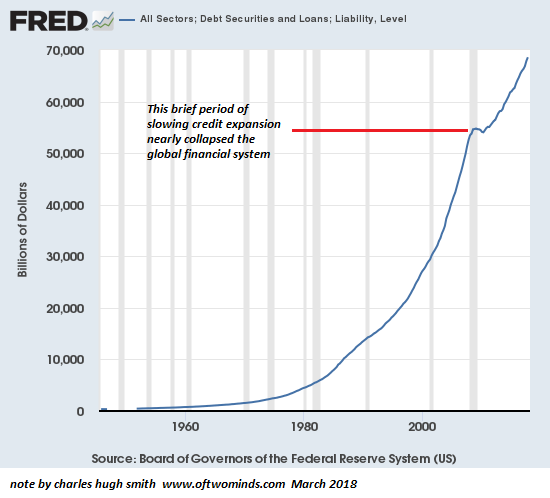The Coming Global Financial Crisis: Debt Exhaustion
February 4, 2019
The global economy is way past the point of maximum debt saturation, and so the next stop is debt exhaustion.
Just as generals fight the last war, central banks always fight the last financial crisis. The Global Financial Crisis (GFC) of 2008-09 was primarily one of liquidity as markets froze up as a result of the collapse of the highly leveraged subprime mortgage sector that had commoditized fraud (hat tip to Manoj S.) via liar loans and designed-to-implode mortgage backed securities.
The central bank "solution" to institutionalized, commoditized fraud was to lower interest rates to zero and enable tens of trillions in new debt. As a result, total debt in the U.S. has soared to $70 trillion, roughly 3.5 times GDP, and global debt has skyrocketed from $84 trillion to $250 trillion. Debt in China has blasted from $7 trillion 2008 to $40 trillion in 2018.
A funny thing happens when you depend on borrowing from the future (debt) to fund growth today: the new debt no longer boosts growth, as the returns on additional debt are increasingly marginal. This leads to what I term debt exhaustion: lenders can no longer find creditworthy borrowers, borrowers either don't want more debt or can't afford more debt, and the cost and risk of the additional debt far outweigh the meager gains. Whatever credit is issued is gambled in speculations that the current bubble du jour will continue indefinitely.
Unfortunately, all central banks know how to do is goose liquidity to inflate asset bubbles and juice the issuance of more debt. If asset bubbles start to deflate, then central banks start buying mortgages, empty flats, stocks and bonds to prop up markets that would otherwise implode.
Equally unfortunately, propping up asset bubbles and stimulating more debt to chase speculative gambles only increases the fragility of the asset bubbles and the economy that has come to rely on them for "growth". A useful concept here is debt saturation: just as an absorbent material can only hold so much water, a corporation, household or economy can only support so much debt before servicing the debt reduces income and increases the risk of default.
The global economy is way past the point of maximum debt saturation, and so the next stop is debt exhaustion: a sharp increase in defaults, a rapid decline in demand for more debt, a collapse in asset bubbles that depend on debt and a resulting drop in economic activity, a.k.a. a deep and profound recession that cannot be "fixed" by lowering interest rates or juicing the creation of more debt.

Pathfinding our Destiny: Preventing the Final Fall of Our Democratic Republic
($6.95 ebook, $12 print):
Read the first section for free in PDF format.
My new mystery
The Adventures of the Consulting Philosopher: The Disappearance of Drake
is a ridiculously affordable $1.29 (Kindle) or $8.95 (print);
read the first chapters
for free (PDF)
My book
Money and Work Unchained is now $6.95 for the Kindle ebook and $15 for the print edition.
Read the first section for free in PDF format.
If you found value in this content, please join me in seeking solutions by
becoming
a $1/month patron of my work via patreon.com.
NOTE: Contributions/subscriptions are acknowledged in the order received. Your name and email remain confidential and will not be given to any other individual, company or agency.
|
Thank you, Bindu M. ($50), for your monumentally generous contribution to this site -- I am greatly honored by your steadfast support and readership. |
Thank you, Wendell D. ($20), for your superbly generous contribution to this site -- I am greatly honored by your steadfast support and readership. |

|